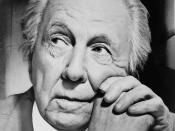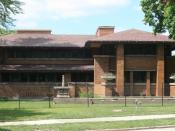Once man started to conquer his environment and manipulate items in nature to provide a shelter for himself, engineers came into existence. As time moved on, rulers wanted their ideas for structures to become a reality and soon ?art? or ?styles? of buildings developed, this created the position of the architect. Always changing is man?s ability to express himself through adapting and manipulating nature, which has created a fascinating legacy in the world of architecture. Architecture has been allowed to evolve only through the advances in technology. Sometimes an architect ?stepped out? on his own with a new style, and risked being laughed at by his peers and society. Luckily for us, many men took this path, challenging technology and allowing for the diverse styles we have today. One such remarkable man during the modern era is Frank Lloyd Wright. It is amazing to review history and see the architectural path that has evolved through technology, and how our buildings are not just structures to shield us from the elements, but also great works of art.
In history as man?s needs changed so did his tools. These tools are really man?s technological advances to support man?s ideas. The early engineers focused on irrigation, military, and structures. History records that Egypt and Mesopotamia developed engineering methods. Unfortunately, many slaves were brought in to create the magnificent buildings and temples, which reflected the power of the rulers. It is interesting to think about how these early men manipulated physics without a computer. With these massive structures came the need to support them with water and waste removal. Greeks ?borrowed? structural ideas and expanded on them to reflect their interests in literature, science, and the arts. Again, they expanded on the ability to support structures through knowledge and manipulation of materials found...


